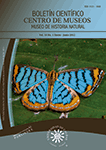Authors
Abstract
The monarch butterfly Danaus plexippus (Linnaeus, 1758) is perhaps one of the most studied species in America, not only because of their migration process and its toxicity, but also because of its beauty and potential for bio-commerce. In Santa Marta (Magdalena, Colombia) it is common to find this species all year round, ovipositing on Calotropis procera (Aiton), a non-native plant also considered as weed. In this study the development of the immature stages of this species on the C. Procera was studied for the first time under lab conditions. The larvae passed through 5 stages in their development, and the cycle, from the oviposition until the adult stage, took place in 23 days. Ninety-nine per cent of the larvae completed the cycle under the test conditions, which show the potential the C. propera has as a host for D. plexippus for the establishment of captive breeding.
References
BRINCKERHOFF, J., 1999. La cría de mariposas: una industria maravillosa en papel. XI Congreso Nacional Agronómico Costarricense.
BROWER, L. P., 1995. Understanding and misunderstanding the migration of the monarch butterfly (Nymphalidae) in North America: 1857-1995. Journal of the Lepidopterist’s Society, 49: 304-385.
CAPINERA, J. L., 2008. Encyclopedia of Entomology. Springer Reference. 4346 p.
COCKRELL, B. J., MALCOLM, S. B. & BROWER, L. P., 1993. Time, temperature and latitudinal constraints on the annual recolonization of eastern North America by the monarch butterfly: 233-255 (en) MALCOLM, S. B., ZALUCKI, M. P. (eds.) Biology and conservation of the Monarch Butterfly. Natural History Museum of Los Angeles County, California.
COLOMBO, R., MARÍN, O., IRAZÁBAL, S. & TEZARA, W., 2007. Relaciones hídricas, fotosíntesis, y anatomía foliar de dos especies del género Calotropis. Interciencia, 32 (11): 791-796.
COSEWIC., 2010. COSEWIC assessment and status report on the Monarch Danaus plexippus in Canada. Committee on the Status of Endangered Wildlife in Canada, 43 p.
ETCHEGARAY, J. B. & NISHIDA, T., 1975. Reproductive activity, seasonal abundance and parasitism of the monarch butterfly, Danaus plexippus (Lepidoptera: Danaidae) in Hawaii. Proceedings Hawaiian Entomological Society, 23 (1): 33-39.
GIBBS, G., 1994. The Monarch Butterfly. Auckland, New Zealand: Reed Publishing.
GIL, F., 2006. A new hostplant for Danaus plexippus (Linnaeus, 1758) in Europe. A study of cryptic preimaginal polymorphism within Danaus chrysippus (Linnaeus, 1758) in southern Spain (Andalusia) (Lepidoptera, Nymphalidae, Danainae). Atalanta, 37 (1-2): 143-149.
LOZADA, P. A., CENDALES, M. H., GÓMEZ, J. A., BECERRA, M. T. & GROUWELS, S., 2006. Desarrollo empresarial comunitario de biocomercio sostenible en Colombia. Aplicación de la metodología análisis y desarrollo de mercado de la FAO. Estudios de casos: Guajira, Quindío y Santander. Instituto de Investigación de Recursos Biológicos Alexander von Humboldt.
MATTILA, H. R., SEARS, M. K. & DUAN, J. J., 2005. Response of Danaus plexippus to pollen of two new Bt corn events via laboratory bioassay. Entomologia Experimentalis et Applicata, 116: 31-41.
MORALES, F., 2001. Calotropis procera (Aiton) W.T. INBio. Especies de Costa Rica. [En línea] Disponible en: http://darnis.inbio.ac.cr/FMPro?-DB=UBIpub.fp3&-lay=WebAll&-Format=/ubi/detail.html&-Op=bw&id=4122&-FindA.
OBERHAUSER, K., 1997. A Field Guide to Monarch caterpillars (Danaus plexippus). National Science Foundation. 16 p.
OBERHAUSER, K. & SOLENSKY, M., 2008. Ecología de la mariposa monarca. ECOLOGIA. INFO 28. [En línea] Disponible en: http://www.ecologia.info/mariposa-monarca.htm.
OBERHAUSER, K., BATALDEN, R. & HOWARD, E., 2009. Monitoreo de la mariposa monarca en América del Norte: Resumen de iniciativas y protocolos. Comisión Para La Cooperación Ambiental. 62 p.
SHAPPERT, P., 2004. Monarch Butterflies: Saving the King of the New World. Key Porter Books, Toronto, Ont. 128 p.
VANE-WRIGHT, R. I., 1993. The Columbus Hypothesis: An Explanation for the Dramatic 19th Century Range Expansion of the Monarch Butterfly: 179-186 (en) MALCOLM, S. B., ZALUCKI, M. P. (eds.) Biology and Conservation of the Monarch Butterfly. Natural History Museum of Los Angeles County, California.
WOODSON, R. E., 1954. The North American species of Asclepias L. Annals of the Missouri Botanical Garden, 41: 1-211.
ZALUCKI, M. P., 1991. Oviposition by Dannaus plexippus (Nymphalidae: Danainae) on Asclepias viridis in Northern Florida. Journal of Lepidopterists’ Society, 45 (3): 215-221.
ZALUCKI, M. P. & MALCOLM, S. B., 1999. Plant latex and first-instar monarch larval growth and survival on three North American milkweed species. Journal of Chemical Ecology, 25 (8): 1827-1842.

 PDF (Español)
PDF (Español)
 FLIP
FLIP


















